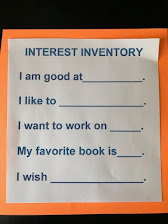"The primary purpose of being four is to enjoy being four—
of secondary importance is to prepare for being five.”
Jim Trelease (Author of THE READ ALOUD HANDBOOK)
and I would add to that...
The primary purpose of being in kindergarten is
to enjoy being in kindergarten.
The secondary purpose is to prepare for first grade.
Doesn't that quote make you pause and think, WHY AM I DOING THIS? Many of you are so busy assessing and collecting data that you don't have time to TEACH! If I were in charge of the world I’d just give all children “A” for effort and say that they were performing at “99%” of their ability. But, I’m not in charge of the world, so here are some suggestions for gathering informal data that will provide a more personal/individualized record of children's growth and development.
Portfolio
Individualize children’s growth by collecting samples of their work each month and saving them in a portfolio. You can use clasp envelopes or gallon zip bags and date each month. Collect a writing sample, self portrait, small motor activity, math page, etc.
Four Square Assessment
At the beginning of each month, have children fold a piece of paper into fourths. Ask them to write/draw the same thing in each square every month. You might have them draw a picture of themselves, write their name, write letters of the alphabet, numbers, shapes, write a story, etc. Adapt to your age level and standards. Date and save for a “reliable” picture of the child’s progress throughout the year.
In addition to saving writing samples and self-portraits in a “portfolio” each month, have children complete an “interest inventory” by filling in sentences similar to the ones below:
I am good at______.
I like to _____.
I want to work on _____.
My favorite book is _____.
I wish _____.
This isn't very high tech, but it's very visual and can be very meaningful. Find an assessment with basic skills you will be focusing on during the year such as upper and lowercase letters, numerals, shapes, sight words, sounds, math facts, etc. Each month assess children and color in the squares they have mastered with a different color of crayon. For example, color what they know in September in red, October - orange, November - brown, etc. It will give a "colorful" picture of the child's learning journey.
Observations
Write down what you observe children doing as they play with classmates, complete assignments, cooperate in group activities, and every day routines.
Hint! Add photos for a visual "insight" into how children are performing.
I AM PROUD!
Let children decorate a folder with their name. Store these in a special tub in the classroom. Encourage the children to save work that they are "proud" of in their folder.

Hint! If you did this with an illustration and writing sample at the beginning of each month they could “revisit” past work and see how they are improving.
One teacher told me she made a sign that said “Testing! Do Not Disturb” and put it on her door when she didn’t want any visitors to see how much fun her class was having. Another teacher told me she wrote: “Disturbed! Do Not Test!” and put it on her door!
P.S. The Massachusetts Department of Early Education provides an excellent overview of the WHAT and WHY for childhood assessment:
http://resourcesforearlylearning.org/fm/early-childhood-assessment/





